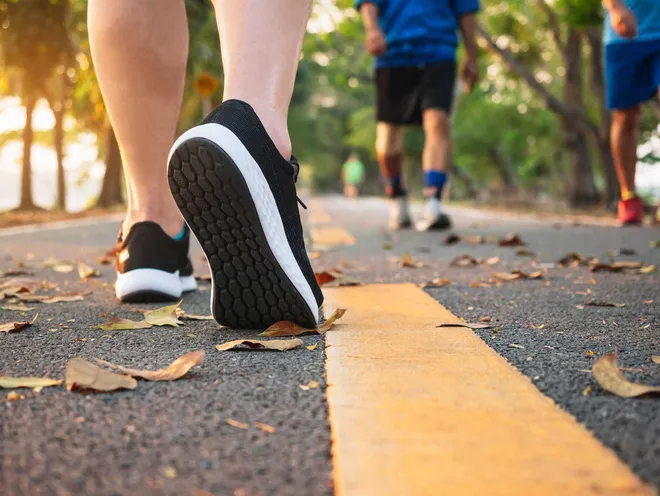How many steps are needed to lose weight?

Adults can prevent weight gain by walking 8,600 steps per day, and those who are currently overweight can reduce their risk of becoming obese by half by walking an extra 2,400 steps per day, or 11,000 steps total.
According to studies, the average person acquires between 1 and 2 pounds (0.5 to 1 kilogram) from their early adult years through middle age, which over time results in an unhealthy weight and even obesity.
Dr. Evan Brittain, the lead author of the study and associate professor in the cardiovascular medicine division at Vanderbilt University Medical Center in Nashville, asserted that people can actually lower their risk of obesity by walking more.
Key findings from the recent study for chronic illnesses and disorders include: According to an email from Brittain, “Diabetes, sleep apnea, hypertension, diabetes, depression, and GERD showed benefit with increased steps.”
In contrast, the relationships with diabetes and hypertension were linear, implying that taking more steps continued to lower risk until roughly 8,000 to 9,000. The key takeaway, in my opinion, is that doing more steps is better.

Another study shows the significant benefits of walking and other forms of exercise for our health. According to the US Centers for Disease Control and Prevention, if you get up and exercise for 21.43 minutes every day of the week, you reduce your chance of dying from all causes by one-third.
Adults are currently advised to engage in 150 minutes of moderate-intensity exercise per week, such as brisk walking, dancing, bicycling, doubles tennis, and water aerobics, as well as two days of muscle-building activity.
Dr. Andrew Freeman, head of cardiovascular prevention and wellness at National Jewish Health in Denver, said in a previous interview that physical activity is “simply absolutely amazing.” And if you combine it with eating a more plant-based diet, relaxing, getting enough sleep, and interacting with others, Freeman added, “There’s your magic potion.” If you will, “It’s the fountain of youth.”
More steps reduce the risk of obesity
The All of Us Research Program at the National Institutes of Health, which conducts studies on how to create personalized health care, includes more than 6,000 people. The study examined activity and health data collected over an average of four years from this group.
Participants in the study, which was released on Monday in the journal Nature Medicine, wore activity trackers for at least ten hours each day and gave researchers permission to view their electronic health records for several years.
“Our study included continuous activity monitoring for an average of 4 years. Because we didn’t have to make any assumptions about activity throughout time, unlike all other research, we were able to account for the entirety of activity between the start of monitoring and the diagnosis of a disease.
The study’s participants varied in age from 41 to 67 and had body mass indices between 24.3 and 32.9, which are considered to be in the range of healthy weight.

According to research, those who walk 4 miles a day, or 8,200 steps, have a lower risk of obesity, sleep apnea, acid reflux, and severe depressive illness. Weight loss, which can ease pressure on the neck and stomach, is effective for treating sleep apnea and acid reflux, while exercise is a cornerstone therapy for depression.
The study also discovered that increasing the daily step count to 11,000 reduced the chance of becoming obese among overweight participants (those with BMIs between 25 and 29) by half. Actually, the study discovered that “this increase in step counts resulted in a 50% reduction in cumulative incidence of obesity after 5 years.”
Applying the data to a specific case, the authors found that increasing daily steps from roughly 6,000 to 11,000 could reduce obesity risk in those with BMIs of 28 by 64%.
A recent study on the advantages of stepping
The latest study confirms findings from a prior study conducted in Spain, which indicated that health benefits increased with each step taken up to a point of 10,000 steps before they started to diminish. For persons who engage in unstructured, ad hoc physical activity, such as cleaning, gardening, and dog walking, counting steps may be particularly crucial.
In a previous interview with CNN, research coauthor Borja del Pozo Cruz said, “Notably, we observed a relationship between incidental steps (steps taken to go about daily life) and a lower risk of both cancer and heart disease.” Del Pozo Cruz is a senior researcher in the field of health sciences at the University of Cadiz in Spain as well as an adjunct associate professor at the University of Southern Denmark in Odense.

The same research team also recently conducted a study that was comparable, which indicated that walking 10,000 steps a day reduced dementia risk by 50%; walking as few as 3,800 steps a day reduced risk by 25%.
However, walking for 30 minutes at a brisk 112 steps per minute reduced dementia risk by 62% while maximizing risk reduction. It wasn’t necessary to do the 30 minutes of brisk walking all at once; it may be stretched out throughout the course of the day.
Researchers discovered that the disease under study affected the relationship between peak 30-minute steps and risk reduction: Dementia risk was reduced by 62%, cardiovascular disease and death risk declined by 80%, and cancer risk decreased by roughly 20%.
Although the connections were “less stable” than with step counts, the new study also identified a link between step intensity and health advantages.
The researchers noted that wearing step trackers tends to make people more active and healthy than average, which poses a significant drawback for any studies employing such devices. However, they added, “The fact that we were able to find high connections between steps and incident disease in this active sample suggests even larger associations may exist in a more sedentary population.
- Your Ultimate Guide to Travel Insurance for Adventure Sports
- A Guide to Renters Insurance for Pet Owners: Pet-Proof Your Policy
- Safeguard Your Future: Understanding Identity Theft Insurance
- Safeguard Your Event: Understanding Event Cancellation Insurance
- Everything You Need to Know About Critical Illness Insurance Riders
- Home Equity Loans vs. HELOCs: Which is Right for You?












